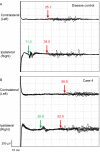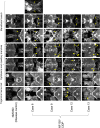Optic, trigeminal, and facial neuropathy related to anti-neurofascin 155 antibody
- PMID: 33080117
- PMCID: PMC7664262
- DOI: 10.1002/acn3.51220
Optic, trigeminal, and facial neuropathy related to anti-neurofascin 155 antibody
Abstract
Objective: To characterize the frequency and patterns of optic, trigeminal, and facial nerve involvement by neuroimaging and electrophysiology in IgG4 anti-neurofascin 155 antibody-positive (NF155+ ) chronic inflammatory demyelinating polyneuropathy (CIDP).
Methods: Thirteen IgG4 NF155+ CIDP patients with mean onset age of 34 years (11 men) were subjected to neurological examination, blink reflex, and visual-evoked potential (VEP) testing, and axial and/or coronal T2-weighted head magnetic resonance imaging (MRI).
Results: Among 13 patients, facial sensory impairment, facial weakness, and apparent visual impairment were observed in three (23.1%), two (15.4%), and two (15.4%) patients, respectively. All 12 patients tested had blink reflex abnormalities: absent and/or delayed R1 in 11 (91.7%), and absent and/or delayed R2 in 10 (83.3%). R1 latencies had strong positive correlations with serum anti-NF155 antibody levels (r = 0.9, P ≤ 0.0001 on both sides) and distal and F wave latencies of the median and ulnar nerves. Absent and/or prolonged VEPs were observed in 10/13 (76.9%) patients and 17/26 (65.4%) eyes. On MRI, hypertrophy, and high signal intensity of trigeminal nerves were detected in 9/13 (69.2%) and 10/13 (76.9%) patients, respectively, whereas optic nerves were normal in all patients. The intra-orbital trigeminal nerve width on coronal sections showed a significant positive correlation with disease duration.
Interpretation: Subclinical demyelination frequently occurs in the optic, trigeminal, and facial nerves in IgG4 NF155+ CIDP, suggesting that both central and peripheral myelin structures of the cranial nerves are involved in this condition, whereas nerve hypertrophy only develops in myelinated peripheral nerve fibers.
© 2020 The Authors. Annals of Clinical and Translational Neurology published by Wiley Periodicals LLC on behalf of American Neurological Association.
Conflict of interest statement
Nothing to report.
Figures





Similar articles
-
Neurofascin IgG4 antibodies in CIDP associate with disabling tremor and poor response to IVIg.Neurology. 2014 Mar 11;82(10):879-86. doi: 10.1212/WNL.0000000000000205. Epub 2014 Feb 12. Neurology. 2014. PMID: 24523485 Free PMC article.
-
Parallel fluctuation of anti-neurofascin 155 antibody levels with clinico-electrophysiological findings in patients with chronic inflammatory demyelinating polyradiculoneuropathy.J Neurol Sci. 2018 Jan 15;384:107-112. doi: 10.1016/j.jns.2017.11.035. Epub 2017 Nov 27. J Neurol Sci. 2018. PMID: 29249367
-
Neurofascin-155 IgG4 in chronic inflammatory demyelinating polyneuropathy.Neurology. 2016 Mar 1;86(9):800-7. doi: 10.1212/WNL.0000000000002418. Epub 2016 Feb 3. Neurology. 2016. PMID: 26843559 Free PMC article.
-
Anti-Neurofascin 155 Antibody-Positive Chronic Inflammatory Demyelinating Polyneuropathy/Combined Central and Peripheral Demyelination: Strategies for Diagnosis and Treatment Based on the Disease Mechanism.Front Neurol. 2021 Jun 10;12:665136. doi: 10.3389/fneur.2021.665136. eCollection 2021. Front Neurol. 2021. PMID: 34177770 Free PMC article. Review.
-
Association of neurofascin IgG4 and atypical chronic inflammatory demyelinating polyneuropathy: A systematic review and meta-analysis.Brain Behav. 2018 Oct;8(10):e01115. doi: 10.1002/brb3.1115. Epub 2018 Sep 21. Brain Behav. 2018. PMID: 30240176 Free PMC article.
Cited by
-
Antibody-Mediated Nodo- and Paranodopathies.J Clin Med. 2024 Sep 25;13(19):5721. doi: 10.3390/jcm13195721. J Clin Med. 2024. PMID: 39407781 Free PMC article. Review.
-
Growing Spectrum of Autoimmune Nodopathies.Curr Neurol Neurosci Rep. 2023 May;23(5):201-212. doi: 10.1007/s11910-023-01264-4. Epub 2023 Apr 4. Curr Neurol Neurosci Rep. 2023. PMID: 37014546 Review.
-
Neurofascin-155 Immunoglobulin Subtypes: Clinicopathologic Associations and Neurologic Outcomes.Neurology. 2021 Dec 14;97(24):e2392-e2403. doi: 10.1212/WNL.0000000000012932. Epub 2021 Oct 11. Neurology. 2021. PMID: 34635556 Free PMC article.
-
An Epitope Platform for Safe and Effective HTLV-1-Immunization: Potential Applications for mRNA and Peptide-Based Vaccines.Viruses. 2021 Jul 27;13(8):1461. doi: 10.3390/v13081461. Viruses. 2021. PMID: 34452327 Free PMC article.
-
Exophthalmos and Supraorbital Bulging in Anti-neurofascin-155 Antibody-positive Neuropathy.Intern Med. 2023;62(2):315-316. doi: 10.2169/internalmedicine.9609-22. Epub 2023 Jan 15. Intern Med. 2023. PMID: 36642533 Free PMC article. No abstract available.
References
-
- Dalakas MC. Advances in the diagnosis, pathogenesis and treatment of CIDP. Nat Rev Neurol. 2011;7:507–517. - PubMed
-
- Joint Task Force of the EFNS and the PNS . European Federation of Neurological Societies/Peripheral Nerve Society Guideline on management of chronic inflammatory demyelinating polyradiculoneuropathy: report of a joint task force of the European Federation of Neurological Societies and the Peripher. J. Peripher. Nerv. Syst. 2010;15:1–9. - PubMed
-
- Saperstein DS, Katz JS, Amato AA, Barohn RJ. Clinical spectrum of chronic acquired demyelinating polyneuropathies. Muscle Nerve 2001;24:311–324. - PubMed
-
- Guibord N, Chalk C, Wein F, et al. Trigeminal nerve hypertrophy in chronic inflammatory demyelinating polyradiculoneuropathy. Neurology 1998;51:1459–1462. - PubMed
-
- Inoue H, Tsuboi Y, Tsugawa J, et al. Hypertrophic cranial nerve roots in CIDP. Neurology 2004;63:1481. - PubMed
Publication types
MeSH terms
Substances
LinkOut - more resources
Full Text Sources
Medical
